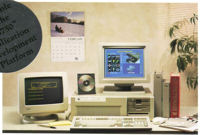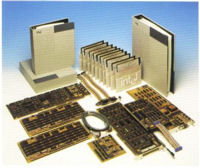![]() It was hubris, of course, to imagine in 1983 that we could play video on a PC (see previous post). It took six more years of prototyping and engineering what we called DVI Technology (for Digital Video Interactive) -- but twenty years ago today, July 21, 1989, we shipped the first commercial DVI product, the Intel Pro750 ADP.
It was hubris, of course, to imagine in 1983 that we could play video on a PC (see previous post). It took six more years of prototyping and engineering what we called DVI Technology (for Digital Video Interactive) -- but twenty years ago today, July 21, 1989, we shipped the first commercial DVI product, the Intel Pro750 ADP.
 This was real video on a PC -- real-time, interactive, full-screen, 30 fps motion video playback with stereo audio -- and streaming from a CD-ROM. And it ran on the 386-based PC/AT platform, under DOS, almost a decade before the introduction of DVD (around 1996 / 1997).
This was real video on a PC -- real-time, interactive, full-screen, 30 fps motion video playback with stereo audio -- and streaming from a CD-ROM. And it ran on the 386-based PC/AT platform, under DOS, almost a decade before the introduction of DVD (around 1996 / 1997).
Our group at RCA Laboratories / David Sarnoff Research Center in Princeton had a unique mix of skills to conceive and create this vision: analog television pioneers and digital TV designers, image / video processing scientists, plus hardware and software engineers with deep experience working on a broad range of products. And we kept the project going though major corporate turmoil: The project started in RCA Laboratories in 1983, G.E. acquired RCA in 1985/86, SRI acquired the Sarnoff Research Center from G.E. in 1987, and finally Intel acquired the DVI Technology and team in 1988.
 This was a non-trivial task. Getting real-time CD-ROM streaming and video and audio decompression running on the PC platform of the time required serious custom hardware -- two DVI Video Display Processor chips (microcode pixel processor and display), and three DVI boards (Video, Audio, Utility / CD-ROM), plus piggyback boards for video memory and video and audio capture.
This was a non-trivial task. Getting real-time CD-ROM streaming and video and audio decompression running on the PC platform of the time required serious custom hardware -- two DVI Video Display Processor chips (microcode pixel processor and display), and three DVI boards (Video, Audio, Utility / CD-ROM), plus piggyback boards for video memory and video and audio capture.
And it required custom system software for reliable continuous real-time data flow under DOS, plus associated custom authoring tools for digital media (video, audio, image capture and compression) and CD-ROM layout.
This first commercial product introduced in July 1989, the Pro750 ADP (Application Development Platform), was designed as a turn-key system for developing multimedia applications. It included an IBM PC/AT-compatible computer with 40 MB hard drive, the full DVI board set, and the DVI software, all for $22,000. The DVI board set, without the digitizers, also was available as the End-User Kit for configuring delivery systems.
Also, this was before standard video formats like MPEG, and before video architectures like Microsoft AVI or Apple QuickTime, so we developed our own compression algorithms to fit the constraints of the available processing power (12.5 MIPS microcode engine) and CD-ROM data rate. The Production-Level Video (PLV) algorithm provided full-screen 30 fps video, but required the use of an off-line compression facility. The Edit-Level Video (ELV) algorithm supported real-time video capture and compression directly on the Pro750 system, to preview the application during development with stand-in video at 10 fps.
See my DVI Technology pages for more on the development of DVI, including chronology, products, pilot applications, publications, and photos and videos.
See Intel Pro750 Product Family for more on the Pro750 product from 1989, including specifications and marketing brochures.
